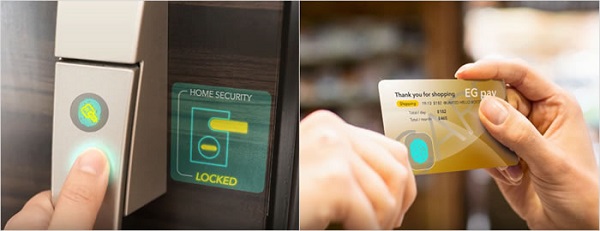Japan Display Inc. (JDI) announced that it has developed a transparent glass-based capacitive fingerprint sensor by applying the company's capacitive multi-touch technology used in its other liquid crystal displays (LCDs). JDI plans to start commercial shipments within its 2018 fiscal year, which ends March of 2019.
 |
|
Sample images of Glass-based Capacitive Fingerprint Sensor (Image: Japan Display Inc.) |
JDI is striving to enter the sensor business arena in preparation for the era of highly-developed security, and gain its new position in this non-display sector by leveraging its experience and know-how fostered through the development of low-temperature poly-silicon (LTPS) LCDs.
JDI's glass-based capacitive fingerprint sensor applies the basic touch functionality technology that is integrated in its in-cell Pixel EyesTM displays which have been used in smartphone and digital still camera applications. With Pixel EyesTM, the touch functionality is integrated into the glass substrate by detecting the changes in capacitance that occur when a finger touches the LCD surface. The glass substrate identifies the area touched by the finger through the detection of the changes in capacitance.
This technology has evolved within JDI to the extent that the company has succeeded in enhancing it to detect the changes in capacitance caused by the recesses and ridges of an individual's fingerprints. This further technological development made it possible to form JDI's new capacitive fingerprint sensor on a transparent glass substrate. JDI will expand the lineup to include larger or smaller sizes as well as this 8mm x 8mm sensor.
In the future, by utilizing JDI's flexible display technology, it is expected that greater degrees of freedom in product design will be enabled by developing thinner and flexible fingerprint sensors.
Currently, most fingerprint sensors used in the marketplace are silicon-based, and thus non-transparent. JDI expects that the advantage of the high transparency of the glass substrate, which silicon-based sensors do not have, combined with a backlight will lead to the expansion of fingerprint sensors in new areas of application.
Given that biometric smartphones and smart cars are becoming wide spread and the era of the Internet of Things (IoT) is underway, high security devices will be required nearly everywhere. Individual certification systems also require even higher security systems, and use fingerprint sensors. Transparent fingerprint sensors should improve the degrees of design freedom to enable such sensors to be installed in nearly every device to make security enhancement much easier. Moreover, JDI's glass-based capacitive fingerprint sensors will be able to replace silicon-based fingerprint sensors that are currently used for smartphone and notebook PC applications.












